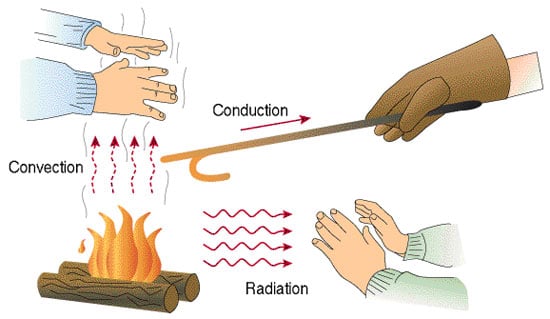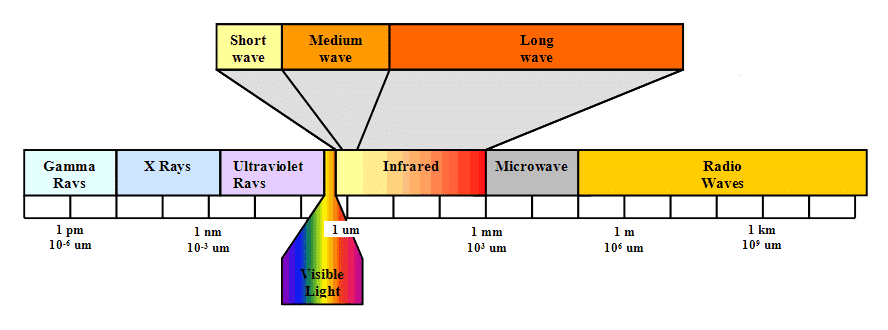
THEORY OF INFRARED HEATING
Share

Infrared heating is a system or appliance that provides heat by thermal radiation. The sun emits infrared rays or thermal radiation that travels approximately 150 000 000 kilometers through cold, dark space. When it reaches the earth surface, it is then absorbed by objects and converted into heat.
MEDIUM WAVE AND LONGWAVE – PREFERABLE WAVELENGTHS
Both longwave and mediumwave wavelengths have very good characteristics, high absorbency, low reflection, and radiation does not penetrate deep into the skin. These features are beneficial for warming up people like for comfort heating. The mediumwave and longwave technology are therefore significantly more efficient and fitting technology compared to shortwave technology that almost completely lacks the required characteristics. Mediumwave and longwave infrared heaters are therefore better suited as radiant heat for comfort heating.
SHORTWAVE IS HIGH INTENSIVE
The shortwave infrared heater that has a very high temperature and therfore has a intensive heat. The high intensity of the shortwave can feel warmer at 2-3 meters, but the majority is reflected and not absorbed by humans. “Warmer” does not mean “more comfortable” or “more efficient” rather, the majority of the energy is wasted in the form of strong light, reflection and low absorption characteristics. However, for comfort heating in windy conditions, a shortwave infrared heater can be a preferable choice due to the higher intensiveness. It can withstand the cooling effects of strong winds better compared to long or medium wave infrared heater.
ICON INFRARED TECHNOLOGY
ICON has various infrared heaters in our product range, which aims at different types of needs and applications. For outdoor comfort warming, we recommend our own developed mediumwave technology (Classic or IR-X) that has a wavelength peak of 2.4μm. It provides a very damp glow and meets the demands of a qualitative infrared heater to heat people. Longwave radiation (IR-C) we recommend for areas that are not exposed to air exchange e.g. indoors, or a fully closed room. Although longwave radiation has good characteristics for comfort heating, the heat intensity is to weak due to its low filament temperature. Which means it does not resist the cooling effect of air movements.
Please contact us for advice or if you have questions!
HEAT TRANSFER
Heat is transferred between objects through conduction, convection or radiation.
- Conduction is the transfer of thermal energy between two forms of matter in direct contact. During conduction, these two forms of matter act to equalise temperature differentials in one another.
- Convection is the transfer of heat caused by a temperature differential between the heated parts of liquid or gas. It is commonly described as the transfer of energy between air and the object in contact.
- Radiation is the transfer of radiant energy from the sourcing matter directly to the object without the means of an intermediary device. Like visible light, radiant energy is passed directly from the source to the object, and the air is not directly heated.

INFRARED RADIATION
The electromagnetic spectrum is the range of all possible frequencies of electromagnetic radiation. It includes gamma rays, X-rays, ultraviolet, visible light, infrared, microwaves and radio waves. Like the sun’s energy, radiant heat energy is emitted in the form of electromagnetic waves in the infrared band, which is located next to the visible light band on the electromagnetic spectrum. The same operating principles apply for manufactured infrared heating appliances.
A VERSATILE HEATING METHOD
Infrared heating, which benefits from radiant heat transfer, allows the source of heat to begin at the floor level and not the ceiling, making infrared heaters an efficient and economical choice for the diverse conditions present in most warehouses, storerooms, and even the largest structures imaginable.
A properly designed infrared heating system can offer numerous benefits including reduced energy consumption. Independent studies have confirmed fuel savings of 20% to 50% when compared to a warm air system. Infrared heaters are a versatile heating method, useful for a wide variety of hard to heat applications. They are proven successful in areas of high air infiltration, buildings with high ceilings, or where spot heating is preferred.
INFRARED WAVELENGTHS
Approximate temperature ranges and the approximate wavelength range measured in microns. A heater filament operating temperature shows us which type of infrared heater it is. Depending on the target material to be heated the correct type of heating radiation needs to be chosen since materials have different levels of absorption levels. If the infrared heating radiation is not correct then only a portion of the heat radiation is absorbed by the remaining material part is wasted or reflected away.

Shortwave (also referred as IR-A or Near Infrared) with wavelengths between 0,78 – 1,4μm
Shortwave Infrared heaters and operate between 780 nm to 1,400 nm and emit temperatures of 1300°C up to 2600°C and a bright visible light. Emitters are typically Quartz filled with halogen gas with a reflector to concentrate the heat in a particular direction.
Mediumwave (also referred as IR-B) with wavelengths between 1,4 – 3,0μm
Medium Wave Infrared heaters operate between 1,400 nm and 3,000 nm and emit temperatures of 500 – 1300°C and produce a deep dimmed red light. Emitters can be Quartz with a reflector to concentrate the heat in a particular direction.
Longwave (also referred as IR-C or Far infrared) with wavelengths between 3,0 – 1000 μm
Longwave infrared heaters operate in the wavelengths above 3,000 nm. Longwave Infrared elements emit much lower temperatures, typically around the 100 – 500°C mark and no visible light.
